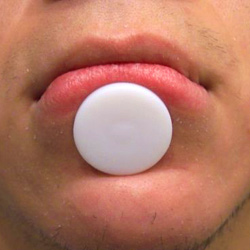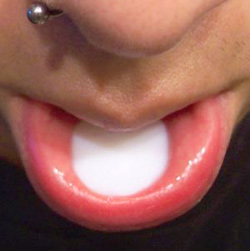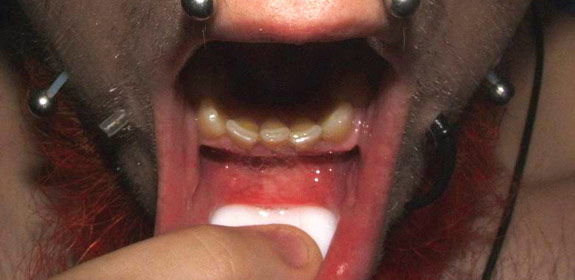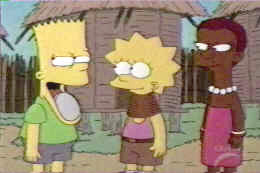 | |||||||||
 Lip Plates Have Reached The West “I may not have gone where I intended to go, but I think I have ended up where I needed to be.”
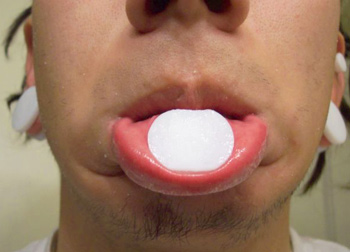 Things have a funny way of inserting themselves into our culture. Ideas, ways of doing things, processes that might have seemed foreign, bizarre, or implausible at one point in history invariably find their ways into our lives; it happens every day. Vaccinations. Hot dogs. Guitars with distortion. Reality Television. But hey, we adapt. We evolve. We roll with the punches. Hell, google is a verb now. A verb! Those are important! But we’re speaking on too grand a scale. Before global change takes place, these little steps occur within each one of us on a microcosmic level. We take our observations, we draw our conclusions, and we make our decisions — though sometimes, not even consciously. “I had no idea that I ever would have taken my lip this far,” says Jesse (IAM:pillpoppinfun). “My parents weren’t too fond of piercings, but I remember saying a long time ago, when my brother first started stretching his ears, that the first piercing they let me have I would stretch it so big that I could stick my fingers through it — and possibly my fist! I didn’t even know that was possible back then!” Things have a way of working out. While a fist-sized hole may be a ways off yet, he’s currently sporting an impressive 3/4" labret with custom-made Teflon jewelry by Karl Lorenz. Jesse goes on: “I figured stretching my lip wouldn’t be that bad; one day in class I went from 14 gauge to 8 gauge [with a taper] and then a 6 gauge. It didn’t feel too great, but that was the first time.” Since then, he has abandoned tapers (“I didn’t like the feeling or the weight,” he says) and now relies on good old-fashioned lube and elbow grease for stretching purposes. What’s remarkable about Jesse’s lip is not the size, though — while large, there are certainly bigger ones in the community — but rather the manner in which he presents it: He is among the first in Western culture to wear his lip piercing down, in much the same way that tribal peoples out of Africa and South America have done — in other words, as a lip plate.
The current applications of this style are more an amalgam of several tribal styles than anything else; the hugely-stretched lips of Ethiopia’s Mursi tribe and the outwardly-projected piercings of Brazil’s Suya are often combined. However, due to the similarities in the original styles it’s near-impossible to narrow down the tribe that these Western examples have most fashioned themselves after. “The Suya/Mursi thing isn’t all that important,” explains Swirly (IAM:Swirly Wanx Sinatra — and yes, that is his real name), “Loads of African [and other] tribes wear big lip plates — those are just the prime examples, the most recognized if you will.” With a labret at just under one inch in diameter, Swirly has one of the larger lips out there — the product of 30 months of persistent stretching — and, as with Jesse, this gives him the ability to wear the jewelry in it down. It’s not something that’s done all the time, though; Swirly maintains that he likes to constantly alternate his jewelry but that his lip will usually flop down on its own when relaxed, while Jesse explains that he’ll wear his lip down on occasion to ease the muscles in the area and to give his teeth and gums a break from the pressure of the jewelry. Both agree that the lip plate style is more soothing, and it certainly seems that when lip piercings get to a certain point, it’s almost the more natural choice. However, there’s no such thing as a free lunch, and a large, heavy piercing in the middle of one’s face is, of course, not without its drawbacks and challenges. The problems Swirly has encountered, he says, have much to do with the weight: “Running up and down stairs is quite hazardous. Speaking takes some getting used to at first. Drinking leaves you rather moist for a while until you learn to drink past your plug. That sort of thing.” Beyond everyday hurdles though, he has also experienced physical issues related to the stretching, including his lower jaw actually changing shape and his teeth beginning to arch backwards as opposed to the normal “U”-shape of the lower jaw.
In a culture where the mainstream is still in its infancy as far as its support and acceptance of more heavily and visibly modified people, when the envelope is pushed as it is being pushed right now, it can seem that there’s almost a “one step forward, two steps back” effect taking place. Forging ahead and breaking new ground before the current path has been steadied and secured will almost invariably result in backlash of some sort, but at the same time — it’s also almost always worth it. It’s obviously not always the case, but hard and heavy can be far more effective than passivity and subtlety on occasion, and if bludgeoning the public for the sake of progress is the only recourse, so be it. “The public’s response to my lip is generally a long stream of profanity.” Swirly claims. “So what do I do? I pop out the plug and stick my split tongue through the hole to add to the shock! And then I’ll get ‘There’s something very wrong with you’ or ‘Why would you do that?’. But really, my response is if you don’t like it, don’t look at it.” “Everyone stares,” Jesse adds. “It’s not something you see every day. Few actually build up the courage to ask about it though, except for ‘Is it really that big?’ or ‘Did that hurt?’, but I do get compliments now and then — usually from the older crowd! My dad always tells them to stop encouraging me though, and we all laugh about it. But definitely more stares than comments for me.”
“The difference between big ears and big lips is the fact that big ears don’t really affect everyday activities like eating, drinking, speaking, and so on,” Swirly offers. And that is important to consider; while stretched ears may have seemed too freaky for anybody’s good at one point, having exposed “wet” tissue is entirely different than large dangling lobes. But people love to complain, and often find something not to like about things that they either don’t understand or feel a warped sense of ownership about, such as a small contingent’s claims of cultural misappropriation against Western suspension practices and really, much of body modification in general. Though, because this “new” lip plating is so directly inspired by tribal and indigenous practices, will accusations of cultural misappropriation and theft be a concern? “I’d turn around and ask them why stretching my lip is any different from the small tattoo they have — you know, ‘because it’s cool’,” says Swirly. “Because tattooing wasn’t originally a Western ‘thing’ either, so surely tattooing anything non-tribal oriented in the true sense of the word is also ‘cultural misappropriation’, and the same goes for piercing. There’s barely anything we do these days [regarding body modification] that hasn’t been done before by tribesmen, and it has all become progressively more acceptable, so why should my lip be any different?”
Jesse isn’t phased by naysayers. For him, the entire process has been a tremendous learning experience. “You could consider it a rite of passage,” he says, “considering that I made it through high school with my lip stretched and passed all of the judgment — I mean, when it came down to it, all I really had for a while was myself. People are forced to mature when put in high-pressure positions from others.”
Jesse, Swirly, and a few others have truly taken the next step. It is people such as them that add creativity into the body modification equation; anybody can jab him — or herself with a needle, but that doesn’t make it art. At a time when piercing seemed to be at a lull of sorts while scarification and implant technology flourished, a movement like this truly brands those involved as pioneers. Did they invent the idea? Hardly. That’s not what this is about. The gravity of the situation lies in the fact that this form of body decoration may be among the first of its kind in Western civilization, and this is very important to acknowledge. It’s this kind of lateral thinking and willingness to experiment and branch out that, in the end, will make all of us look good. Will the anthropology and sociology textbooks 200 years from now be more concerned with the impact that Nick and Jessica’s Variety Hour had on society, or will they be examining the major paradigm shifts and cultural revolutions that came out of communities such as ours? There was a time when an eyebrow piercing was about as edgy as one could get. There was a time when people in this community could not get behind large-gauge lobe piercings. This may seem very different right now, but things have a way of reaching a sense of normalcy and acceptance. Now that I think about it, maybe the future generations won’t read about things like this in textbooks; they’ll just google it instead. Now that still sounds weird to me.
- Jordan Ginsberg (iam:snackninja) 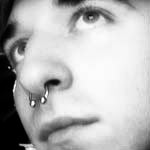
A recent acquisition from the illustrious, high-profile world of low-budget sporting-goods photography, Jordan Ginsberg is a Toronto native. Born affiliated to the Levi tribe, Jordan renounced his religion shortly before his Bar Mitzvah but still believes he is entitled to a role in the liberal Jew-run media and sees BME as an ideal stepping stone. Votes left, throws right. Article copyright © 2005 BMEZINE.COM. First published February 3rd, 2005 in La Paz, BCS, Mexico. Requests to reprint must be confirmed in writing.
|
|||||||||
